8.8E: Ejercicios
- Page ID
- 112495
La práctica hace la perfección
En los siguientes ejercicios, evalúe cada función.
- \(f(x)=\sqrt{4 x-4}\), encuentra
- \(f(5)\)
- \(f(0)\)
- \(f(x)=\sqrt{6 x-5}\), encuentra
- \(f(5)\)
- \(f(-1)\)
- \(g(x)=\sqrt{6 x+1}\), encuentra
- \(g(4)\)
- \(g(8)\)
- \(g(x)=\sqrt{3 x+1}\), encuentra
- \(g(8)\)
- \(g(5)\)
- \(F(x)=\sqrt{3-2 x}\), encuentra
- \(F(1)\)
- \(F(-11)\)
- \(F(x)=\sqrt{8-4 x}\), encuentra
- \(F(1)\)
- \(F(-2)\)
- \(G(x)=\sqrt{5 x-1}\), encuentra
- \(G(5)\)
- \(G(2)\)
- \(G(x)=\sqrt{4 x+1}\), encuentra
- \(G(11)\)
- \(G(2)\)
- \(g(x)=\sqrt[3]{2 x-4}\), encuentra
- \(g(6)\)
- \(g(-2)\)
- \(g(x)=\sqrt[3]{7 x-1}\), encuentra
- \(g(4)\)
- \(g(-1)\)
- \(h(x)=\sqrt[3]{x^{2}-4}\), encuentra
- \(h(-2)\)
- \(h(6)\)
- \(h(x)=\sqrt[3]{x^{2}+4}\), encuentra
- \(h(-2)\)
- \(h(6)\)
- Para la función\(f(x)=\sqrt[4]{2 x^{3}}\), encontrar
- \(f(0)\)
- \(f(2)\)
- Para la función\(f(x)=\sqrt[4]{3 x^{3}}\), encontrar
- \(f(0)\)
- \(f(3)\)
- Para la función\(g(x)=\sqrt[4]{4-4 x}\), encontrar
- \(g(1)\)
- \(g(-3)\)
- Para la función\(g(x)=\sqrt[4]{8-4 x}\), encontrar
- \(g(-6)\)
- \(g(2)\)
- Contestar
-
1.
- \(f(5)=4\)
- sin valor en\(x=0\)
3.
- \(g(4)=5\)
- \(g(8)=7\)
5.
- \(F(1)=1\)
- \(F(-11)=5\)
7.
- \(G(5)=2 \sqrt{6}\)
- \(G(2)=3\)
9.
- \(g(6)=2\)
- \(g(-2)=-2\)
11.
- \(h(-2)=0\)
- \(h(6)=2 \sqrt[3]{4}\)
13.
- \(f(0)=0\)
- \(f(2)=2\)
15.
- \(g(1)=0\)
- \(g(-3)=2\)
En los siguientes ejercicios, encuentra el dominio de la función y escribe el dominio en notación de intervalos.
- \(f(x)=\sqrt{3 x-1}\)
- \(f(x)=\sqrt{4 x-2}\)
- \(g(x)=\sqrt{2-3 x}\)
- \(g(x)=\sqrt{8-x}\)
- \(h(x)=\sqrt{\frac{5}{x-2}}\)
- \(h(x)=\sqrt{\frac{6}{x+3}}\)
- \(f(x)=\sqrt{\frac{x+3}{x-2}}\)
- \(f(x)=\sqrt{\frac{x-1}{x+4}}\)
- \(g(x)=\sqrt[3]{8 x-1}\)
- \(g(x)=\sqrt[3]{6 x+5}\)
- \(f(x)=\sqrt[3]{4 x^{2}-16}\)
- \(f(x)=\sqrt[3]{6 x^{2}-25}\)
- \(F(x)=\sqrt[4]{8 x+3}\)
- \(F(x)=\sqrt[4]{10-7 x}\)
- \(G(x)=\sqrt[5]{2 x-1}\)
- \(G(x)=\sqrt[5]{6 x-3}\)
- Contestar
-
1. \(\left[\frac{1}{3}, \infty\right)\)
3. \(\left(-\infty, \frac{2}{3}\right]\)
5. \((2, \infty)\)
7. \((-\infty,-3] \cup(2, \infty)\)
9. \((-\infty, \infty)\)
11. \((-\infty, \infty)\)
13. \(\left[-\frac{3}{8}, \infty\right)\)
15. \((-\infty, \infty)\)
En los siguientes ejercicios,
- encontrar el dominio de la función
- graficar la función
- usar la gráfica para determinar el rango
- \(f(x)=\sqrt{x+1}\)
- \(f(x)=\sqrt{x-1}\)
- \(g(x)=\sqrt{x+4}\)
- \(g(x)=\sqrt{x-4}\)
- \(f(x)=\sqrt{x}+2\)
- \(f(x)=\sqrt{x}-2\)
- \(g(x)=2 \sqrt{x}\)
- \(g(x)=3 \sqrt{x}\)
- \(f(x)=\sqrt{3-x}\)
- \(f(x)=\sqrt{4-x}\)
- \(g(x)=-\sqrt{x}\)
- \(g(x)=-\sqrt{x}+1\)
- \(f(x)=\sqrt[3]{x+1}\)
- \(f(x)=\sqrt[3]{x-1}\)
- \(g(x)=\sqrt[3]{x+2}\)
- \(g(x)=\sqrt[3]{x-2}\)
- \(f(x)=\sqrt[3]{x}+3\)
- \(f(x)=\sqrt[3]{x}-3\)
- \(g(x)=\sqrt[3]{x}\)
- \(g(x)=-\sqrt[3]{x}\)
- \(f(x)=2 \sqrt[3]{x}\)
- \(f(x)=-2 \sqrt[3]{x}\)
- Contestar
-
1.
- dominio:\([-1, \infty)\)
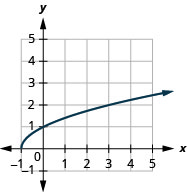
Figura 8.7.8- \([0, \infty)\)
3.
- dominio:\([-4, \infty)\)
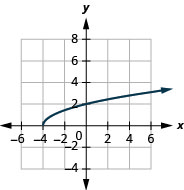
Figura 8.7.9- \([0, \infty)\)
5.
- dominio:\([0, \infty)\)
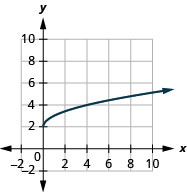
Figura 8.7.10- \([2, \infty)\)
7.
- dominio:\([0, \infty)\)
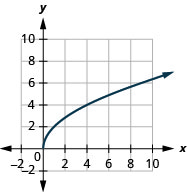
Figura 8.7.11- \([0, \infty)\)
9.
- dominio:\((-\infty, 3]\)
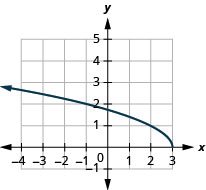
Figura 8.7.12- \([0, \infty)\)
11.
- dominio:\([0, \infty)\)
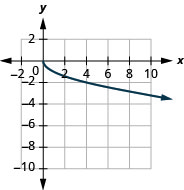
Figura 8.7.13- \((-\infty, 0]\)
13.
- dominio:\((-\infty, \infty)\)
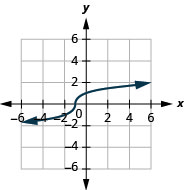
Figura 8.7.14- \((-\infty, \infty)\)
15.
- dominio:\((-\infty, \infty)\)
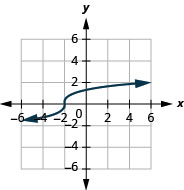
Figura 8.7.15- \((-\infty, \infty)\)
17.
- dominio:\((-\infty, \infty)\)
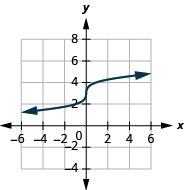
Figura 8.7.16- \((-\infty, \infty)\)
19.
- dominio:\((-\infty, \infty)\)
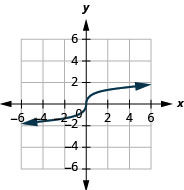
Figura 8.7.17- \((-\infty, \infty)\)
21.
- dominio:\((-\infty, \infty)\)
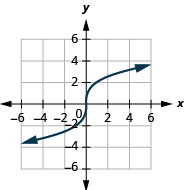
Figura 8.7.18- \((-\infty, \infty)\)
- Explicar cómo encontrar el dominio de una cuarta función raíz.
- Explicar cómo encontrar el dominio de una quinta función raíz.
- Explique por qué\(y=\sqrt[3]{x}\) es una función.
- Explicar por qué el proceso de encontrar el dominio de una función radical con un índice par es diferente del proceso cuando el índice es impar.
- Contestar
-
1. Las respuestas pueden variar
3. Las respuestas pueden variar
Autocomprobación
a. después de completar los ejercicios, utilice esta lista de verificación para evaluar su dominio de los objetivos de esta sección.

b. ¿Qué te dice esta lista de verificación sobre tu dominio de esta sección? ¿Qué pasos tomarás para mejorar?


